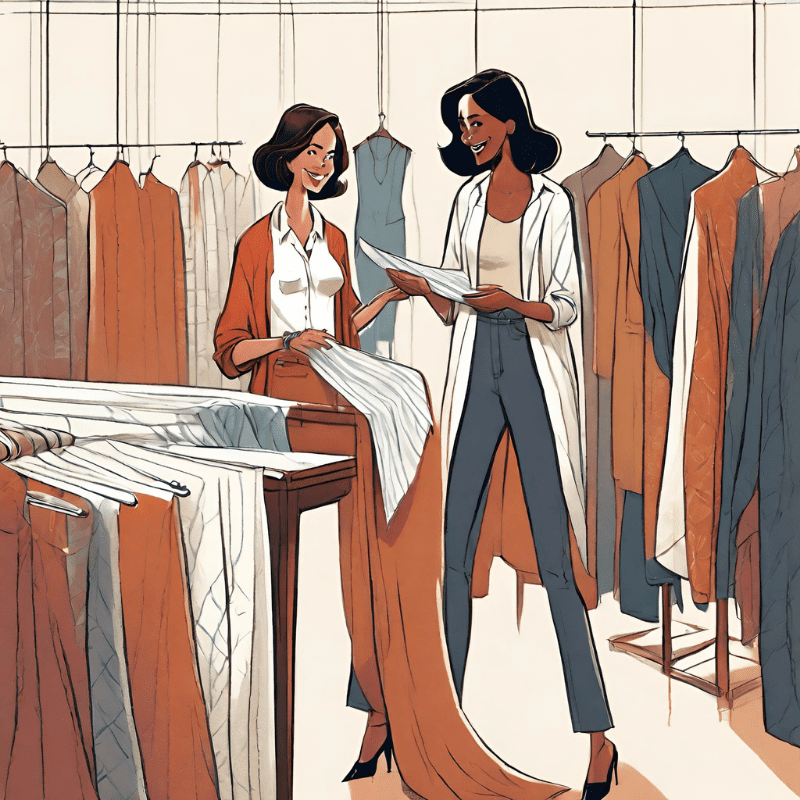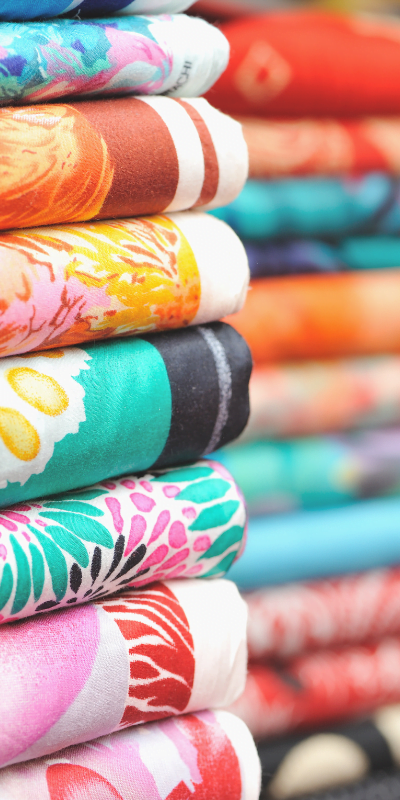
Fabric 101 for Designers: How to Select Your Fabrics
Written by DoraFashion
Embark on a journey into the heart of fabric selection with our comprehensive guide. From understanding the unique characteristics of each fabric type to exploring their diverse textures, drapes, and movements, this guide is your passport to crafting exceptional designs. Dive deep into the world of fabrics, unravel their secrets, and master the art of pairing them with design accents for truly captivating creations. Let’s weave the fabric of your imagination into fashion reality!
Expectations from the Design
Crafting Dreams: Defining the Vision
Every fabric possesses a distinctive personality, capable of enhancing or even defining the entire design. Understanding this intrinsic quality is crucial for a designer. Some fabrics exude a robust, structured aura, while others flow with graceful fluidity.
Before diving into the creative process, a designer must meticulously define their expectations from the design. This encompasses envisioning how the fabric will interact with various design accents. Whether aiming for a bold, impactful statement or a subtle, understated elegance, aligning design expectations with fabric choice sets the foundation for a harmonious and impactful final product. Consider how the chosen fabric will influence the overall feel, drape, and movement of the garment, thus shaping the wearer’s experience.

Fabric Characteristics
Fabric
Textile Symphony: Understanding Fabric Features.

Every fabric is a universe of unique characteristics. From texture and weight to opacity and sheen, each aspect contributes to its distinct identity. Understanding these traits empowers a designer to make informed choices. For instance, a dense, heavyweight fabric can add structure and drama to a design, while a lightweight, sheer fabric lends an airy, ethereal quality. Delving into these characteristics allows designers to harmonize their vision with the fabric’s inherent attributes.
Basic Characteristics of Fabrics
- Texture: From smooth to textured, fabrics vary in their tactile quality. This influences the sensory experience for the wearer.
- Weight: The heft of a fabric impacts its suitability for different types of garments. Heavyweight fabrics offer structure and warmth, while lightweight options lend themselves to flowing, breezy designs.
- Opacity: Some fabrics are sheer, allowing light to pass through, while others offer full coverage. This aspect affects the garment’s transparency and layering potential.
- Sheen: The level of shine in a fabric can range from matte to high gloss, contributing to its visual appeal.
- Overall Feel: Fabrics possess tactile sensations ranging from soft and supple to crisp and rigid. This directly impacts the comfort and tactile experience for the wearer.

Drape Characteristics
Understanding how a fabric drapes and moves is essential for creating garments that flow harmoniously with the body. Here’s a closer look at these crucial aspects:
- Drape: This refers to how a fabric falls or hangs when draped over a form or on the body. Fabrics with excellent drapes create graceful, flowing lines, enhancing the overall aesthetic of the garment.
- Example 1: Chiffon
Chiffon is renowned for its ethereal drape. Its lightweight and sheer nature allows it to cascade gently, creating a romantic, floating effect in dresses and overlays. - Example 2: Silk Satin
Silk satin offers a luxurious, fluid drape. It clings to the body in a way that emphasizes curves, making it an excellent choice for elegant evening gowns. - Example 3: Crepe
Crepe fabric, with its crinkled texture, provides a unique drape that is both relaxed and textured. It’s versatile and can be used for a variety of garments, from blouses to dresses. - Example 4: Cupro
Cupro is known for its smooth and silky drape. It flows effortlessly and resembles the luxurious drape of silk, making it a popular choice for high-quality garments.
- Example 1: Chiffon
Movement Characteristics
- Movement: This pertains to how a fabric behaves when in motion. Some fabrics sway and ripple, while others remain structured and firm.
- Jersey Knit:
Jersey knit exhibits excellent stretch and recovery, providing a fabric that moves effortlessly with the body. This makes it a popular choice for comfortable, form-fitting garments like T-shirts and dresses. - Cotton-based Fabrics:
Cotton-based fabrics, including denim, offer a structured movement. While they provide less stretch, they are sturdy and maintain their shape even during active wear, making them suitable for a range of casual clothing. - Crepe: Crepe fabrics possess a unique textured surface that contributes to their movement. They exhibit a relaxed, fluid sway, making them a versatile choice for a range of garments.
- Example: Crepe de Chine
Crepe de Chine is known for its luxurious drape and gentle movement. Its soft, slightly crinkled texture allows for elegant, flowing designs in blouses, dresses, and more.
- Example: Crepe de Chine
- Cupro: Cupro is celebrated for its smooth and silky drape, which translates into graceful movement. This fabric flows effortlessly with the body, providing an elegant way that adds sophistication to any garment.
- Example: Cupro Twill
Cupro twill fabric maintains a structured movement while still offering a luxurious drape. Its slightly heavier weight makes it suitable for both tailored and flowing designs.
- Example: Cupro Twill
- Satin: Satin fabrics offer a luxurious, fluid movement characteristic. They delicately cling to the body, emphasizing curves and creating a glamorous effect, making them an excellent choice for formal and eveningwear.
- Example: Silk Satin
Silk satin, in particular, epitomizes this characteristic. Its smooth surface and exquisite drape elevate garments to a level of opulence, making it a preferred choice for high-end fashion.
- Example: Silk Satin
- Jersey Knit:
Design Accents
The Devil is hiding in the details.
Design accents are the intricate details that complete a garment. Ruffles, pleats, lace, and embroidery are just a few examples. The chosen fabric should not only complement these accents but elevate them, creating a cohesive and visually captivating ensemble. Each fabric lends a unique texture, structure, and depth to these details, significantly influencing the overall aesthetic.
- Ruffles: Ruffles are delicate, gathered or pleated strips of fabric that add volume and movement to a garment. They can be applied along hems, necklines, or sleeves for a romantic or playful look.
- Pleats: Pleats are folds in fabric that create structured, tailored details. They can be narrow or wide, adding dimension and texture to a design. Accordion pleats create a more fluid movement, while box pleats offer a crisper, formal appearance.
- Gathers: Gathers are created by bunching fabric together, providing volume and fullness. They are often used in skirts, sleeves, or bodices to create a soft, draped effect.
- Fringes: Fringes are decorative trims made of strands of fabric, adding a playful, textured element to a design. They’re commonly used on accessories, such as scarves or bags.
- Flounces: Flounces are similar to ruffles but are typically larger and create a more dramatic effect. They’re often used to add movement and flair to skirts or sleeves.
- Ruching: Ruching involves gathering fabric in a controlled manner to create texture and dimension. It’s commonly used to accentuate specific areas of a garment, like the bodice or sides.
- Lace: Lace is a delicate, openwork fabric often used as an overlay or trim on garments. Its intricate patterns add a touch of elegance and femininity to designs.
- Appliqué: Appliqué involves attaching pieces of fabric onto a base fabric to create decorative patterns or images. This technique allows for customization and can add depth to a design.
- Embroidery: Embroidery is the art of decorating fabric with intricate stitched designs. It can range from simple patterns to elaborate motifs, providing a personalized and artistic touch to a garment.

Perfect Pairings:
Selecting Fabrics for Design Accents
Ruffles: Ruffles create a playful, feminine look and work best with lightweight, flowy fabrics like chiffon or silk.
- Suitable Fabrics: Chiffon, Organza, Silk, Satin
Pleats: Pleats add structure and texture. Fabrics like cotton and linen hold pleats well due to their natural stiffness.
- Suitable Fabrics: Cotton, Linen, Polyester Blends
Gathers: Gathers create volume and movement. Lighter fabrics like voile or jersey knit are ideal for achieving this effect.
- Suitable Fabrics: Voile, Tulle, Jersey Knit
Fringes: Fringes add a tactile element. Heavier fabrics like suede or denim provide the necessary weight for fringes.
- Suitable Fabrics: Suede, Leather, Denim
Flounces: Flounces create a romantic, cascading effect. Lightweight fabrics like crepe or chiffon are perfect for flounces.
- Suitable Fabrics: Crepe, Chiffon, Organza
Ruching: Ruching gathers fabric in a controlled manner. Stretchy fabrics like jersey knit or spandex blends are best for achieving this effect.
- Suitable Fabrics: Jersey Knit, Lycra, Spandex Blends
Categories
Dora Fashion
Fabrics
Manufacturing
Fashion Design
Marketing & Branding
Related Articles
Related
How To Create a TechPack : Fashion Design 101
In The Fashion Industry, A Tech Pack Is The Cornerstone Of Successful Garment Production. With Your Custom Template, You're Empowered To Streamline The Process, Ensuring Precise Communication Between Your Vision And The Manufacturers.Creating a Comprehensive TechPack:...
Fashion Design 101: Understanding the Basics
Welcome to "Fashion Designs 101: Understanding the Basics." This series is your gateway into the exciting world of fashion design. From fundamental techniques to the art of color selection and finding creative inspirations, join us on a journey that unlocks the...
Fashion Design 101: How to Sketching from Concept to Creation
Embark on a fascinating journey into the world of fashion sketching! Explore the intricacies of turning your conceptual ideas into tangible designs. This series delves into the art of sketching, guiding you through the process of transforming your imagination into...


Very nice job!
Appreciate! Please make more contents about fabrics.
Woah! I’m really loving the knowledge of this blog. It’s simple, yet effective.
A lot of times it’s challenging to get that “perfect balance” between usability and
visual appeal. I must say you have done a very good job
with this.